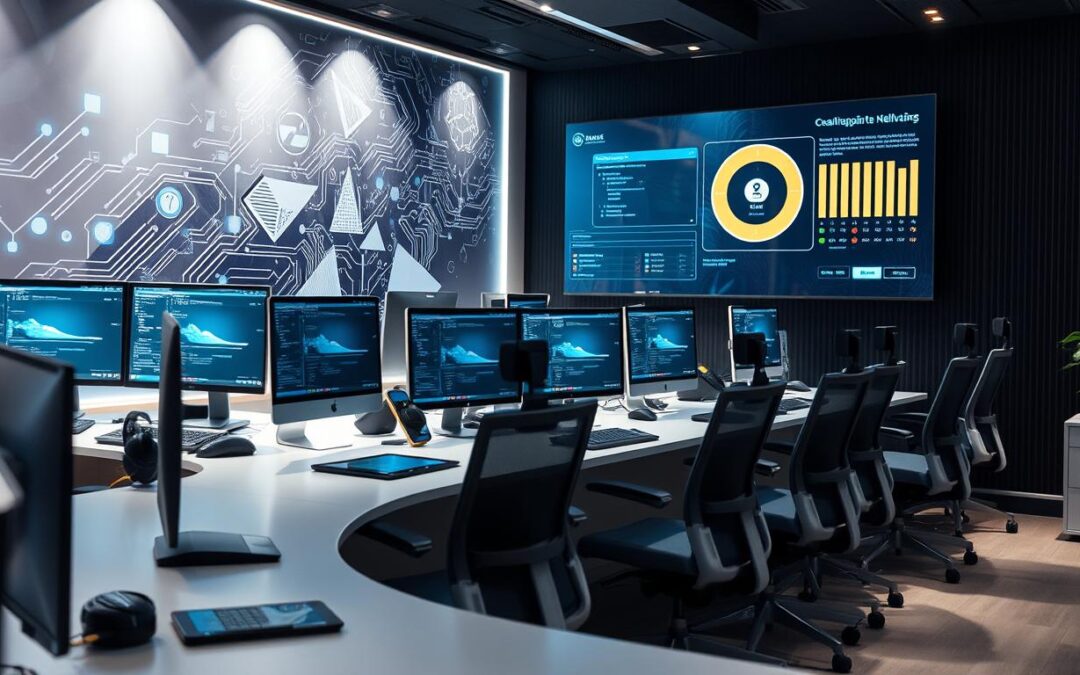Over 7,000 support experts worldwide trust Helpdesk and Tech Support. These services are crucial for both individuals and businesses. With technology advancing, reliable support is more important than ever. A single service desk offers quick, informed help for all IT needs.
Robust reporting and analytics track trends and customer satisfaction. Agents can solve problems faster with automated workflows. Ticket routing is automated, giving answers in seconds. Companies like Brastel use Helpdesk and Tech Support to improve their service desk.
Helpdesk support solves many problems, eliminating the need for multiple contacts. For serious issues, on-site support is available. Helpdesk staff also recommend the latest tech to keep systems running smoothly. Many providers offer 24/7 support, ensuring help is always available.
Key Takeaways
- Helpdesk and Tech Support services provide 24/7 support to customers
- A centralized service desk enables prompt, data-driven assistance for all customer IT requests
- Automated workflows and ticket routing improve response times and efficiency
- Helpdesk support can address a variety of problems, reducing the need for multiple contacts
- On-site support is available for severe failures requiring in-depth knowledge
- Helpdesk personnel provide recommendations on the latest software and hardware tools
- Implementing robust reporting and analytics helps track trends, agent performance, and customer satisfaction
Understanding Modern Helpdesk & Tech Support Services
Modern helpdesk and tech support services have changed a lot. They now offer quick and effective solutions to customers. Technical Support is key in today’s world. It aims to give Customer Service that really meets customer needs, solving problems fast.
Modern helpdesk services use automation, AI, and secure data management. These tools help manage lots of support requests. They also let teams focus on the most urgent issues. Computer Support teams use software for tasks like server upkeep and software updates.
Definition and Core Components
A modern helpdesk is the main spot for Technical Support in an organization. It’s where customers go to report problems and get help. Helpdesk software has ticketing systems, automation tools, and analytics for reporting.
Evolution of Technical Support
Technical Support has moved from just phone calls to many different ways to help. This change makes Customer Service better and more efficient. It meets the needs of today’s customers.
Current Industry Standards
Today, helpdesk and tech support use ticketing systems, AI, and secure data management. These standards help organizations offer Computer Support that’s fast, effective, and safe. They meet customer needs and solve problems quickly.
Benefits of Professional IT Support Solutions
Having a professional IT Helpdesk support contact can change the game for businesses. They get instant help and support 24/7. This means they can fix technical issues fast, saving time and money. Helpdesk Solutions tackle many hardware and software problems, keeping businesses running smoothly.
Key benefits of professional IT Troubleshooting include less downtime and better efficiency. Outsourcing IT Helpdesk services means businesses save on hiring and training costs. This leads to big savings, as costs match demand changes.
Professional IT Support also does tech audits to meet rules like GDPR. This stops unauthorized access and data breaches, avoiding big fines and damage to reputation. Using Helpdesk Solutions boosts efficiency and productivity. This makes employees happier and reduces work stoppages.
Some stats show the value of professional IT Support:
- 60% of small and medium-sized businesses hit by cyber-attacks fail within six months
- Outsourcing managed IT Support stops tech problems and costly downtime
- Companies that outsource IT Support save 20% to 40% on yearly IT costs
Essential Features of Quality Tech Support Services
Quality tech support services are key for quick and effective help to customers. They offer 24/7 support, many ways to get help, and strong security. This means customers can get help by email, phone, or live chat anytime.
Studies show that 24/7 availability is very important. It lets customers get help whenever they need it. Also, multi-channel support options
Other important features are scalability and flexibility. These help support services meet changing customer needs. Strong security protocols protect customer data and keep it safe from unauthorized access.
By having these features, tech support services can offer great support. This leads to happier customers and more loyalty. With Remote Assistance and Customer Service, companies can build trust and loyalty with their customers.
Remote Assistance Technologies and Tools
Remote assistance is key in helpdesk solutions. It lets support teams access customers’ computers from afar. This way, they can fix technical issues quickly. With more people working from home, remote assistance tools are more important than ever.
These tools let users work on their computers as if they were in the office. Administrators can fix problems without being there, saving time for everyone. Tools like BeyondTrust, ConnectWise Control, and Parallels RAS are popular. They offer features like file sharing, chat, and support for multiple monitors.

These tools also have strong security features. They include two-factor authentication and session timeouts. This makes remote work safe. Companies like Amazon, Splashtop, and LogMeIn are leading the way with new solutions.
Recent data shows a big increase in spending on remote desktop software. Over 50% of companies plan to spend more. Also, 85% of IT pros say remote support tools make their job easier. As the market grows, investing in good remote assistance tools is crucial for businesses.
Using helpdesk solutions with remote assistance has many benefits. It reduces downtime and keeps customers happy. With the right tools, businesses can offer quick and effective support. This improves customer experience and loyalty.
Common Technical Issues and Resolution Methods
Technical Support teams face many common problems like hardware failures, software conflicts, and network issues. They use IT Troubleshooting to fix these problems. This way, they keep systems running smoothly and quickly.
Some common issues include hardware failures, software problems, and network issues. Technical Support teams use a step-by-step method to solve these problems. They do diagnostics, testing, and apply fixes. This approach helps solve problems quickly and with little impact on work.
Fixing technical issues needs technical skills, problem-solving, and good communication. Support teams must gather info, analyze it, and find the main problem. They also need to explain the issue and solution clearly to users.
Some key steps in IT Troubleshooting include:
- Gathering info from logs, user reports, and error messages
- Finding the main cause of the problem, using tools like Nmap and Wireshark
- Applying fixes, including managing downtime, downloading patches, and testing in a staging area
- Checking if the system works, involving users and getting their feedback
By following a structured IT Troubleshooting approach, Technical Support teams can solve common problems quickly. This reduces downtime and improves system performance. It ensures business operations run smoothly, and users can work without many technical interruptions.
The Role of Artificial Intelligence in Modern Helpdesk Solutions
Artificial intelligence (AI) is changing how helpdesk solutions work. It lets businesses give better support to their customers. AI tools help IT teams do routine tasks, so they can tackle harder problems.
This makes customers happier and helps support staff not get too tired. It also makes their jobs more enjoyable.
AI brings many benefits, like automated ticketing systems. These systems sort and rank tickets by how urgent and complex they are. Chatbots and virtual assistants also help by answering simple questions and solving easy problems.
A SurveyMonkey study found 90% of people like talking to humans more than chatbots. This shows we need a mix of AI and human touch for the best support.
AI can also look at lots of data to understand what customers want. This helps predict and solve problems before they start. By using AI, companies can make their support services better, making customers happier and more loyal.
- 77% of customers feel more loyal to companies that provide excellent service and customer support
- AI helps reduce customer touchpoints and personnel headcounts in help desk operations
- AI-enabled automation allows agents to focus on high-value tasks by eliminating repetitive, low-value jobs
These facts show how much AI can improve helpdesk solutions. They also show why businesses should invest in AI to stay ahead.
Choosing the Right Helpdesk / Tech Support Provider
Choosing a helpdesk or tech support provider is important. You need someone who can fix technical issues fast and well. Look at their reputation, expertise, and customer service to make a good choice.
Some important things to think about are:
- 24/7 availability for support
- Transparent communication regarding services, processes, and fees
- Positive reviews from previous clients
- Scalability of services to meet growing business needs
- Cultural fit between the client’s business and the tech support team
A good helpdesk can make customers happier by 20%. Using helpdesk services can cut costs by 30%. Companies that offer help and self-help materials see a 40% drop in support queries.
When picking a helpdesk or tech support provider, check if they can meet your needs. They should offer services like cybersecurity, data backups, and software maintenance. Good Customer Service is key to solving problems quickly and well.
Implementation Strategies for Businesses
Businesses need to think carefully when setting up IT Helpdesk solutions. They must plan well, integrate with current systems, and train staff. This way, they can make customers happier and save time on routine tasks.
Integrating the new system with what they already have is key. This makes sure customers get a smooth experience. It also helps avoid misunderstandings and makes support work better. Training staff is also important to make sure they can quickly help customers.

Good implementation brings many benefits. Customers are happier, problems are fixed faster, and staff work better. Using Helpdesk Solutions that let teams work together can cut down problem-solving time by 40%. It also makes sure everyone involved knows what’s going on. Plus, automating Helpdesk tasks can make staff 30% more productive by freeing them from boring tasks.
To do well, businesses should focus on a few main things:
- Assessment and planning: Check what they have and see where they can get better.
- Integration process: Make sure the new system works well with what they already have.
- Staff training requirements: Make sure staff can handle customer questions and solve problems fast.
Measuring Support Service Performance
It’s key to measure support service performance to see how well they’re doing. Important metrics like ticket volume, first response time, and how quickly issues are solved help manage staff. They also show how good the Tech Support is.
A good help desk keeps the number of tickets opened and solved the same. Customer Service scores and net promoter scores tell us how happy customers are. Remote Assistance tools can make support faster and more effective.
To check how well support services are doing, help desks look at things like how often they solve problems first time. They also watch ticket backlogs and how busy agents are. These numbers help find where things can get better. This way, support teams can work smarter and give better Tech Support and Customer Service.
Future Trends in Technical Support Services
The future of technical support is changing fast. It will be more personalized, efficient, and automated. A Gartner study shows 91% of businesses will use AI for customer service soon. This shows how important IT Helpdesk solutions with AI are.
Some key trends shaping the future of technical support include:
- Increased use of AI-powered tools to enhance Helpdesk Solutions
- Greater emphasis on cloud-based solutions for scalability and flexibility
- Growing demand for multilingual support to cater to diverse customer bases
- More businesses outsourcing technical support to reduce costs and improve KPIs
A Salesforce survey found 88% of customers value the experience a company offers as much as its products or services. This highlights the need for Technical Support that is efficient, personalized, and quick to respond to customer needs.
As technology keeps getting better, IT Helpdesk solutions need to keep up. By embracing these trends, companies can make their Helpdesk Solutions better. This will help them stay competitive in the fast-changing world of technical support.
Best Practices for Maximizing Support Efficiency
To make support better, focus on what customers want and make processes smoother. A good helpdesk system helps solve problems fast. This makes customers happy and keeps them coming back.
Good tech support needs tech skills, good communication, and caring for customers. It’s all about solving problems well and making customers feel valued.
Some top ways to improve support include a detailed knowledge base, automated ticket systems, and support through many channels. Offering many ways to reach customer service can boost satisfaction by 30%. Also, having a single view of the customer helps agents work 20% better by knowing the customer’s history.
- Implementing self-service portals to reduce overall ticket volume
- Utilizing canned responses to improve response times to common inquiries
- Regularly reviewing key performance indicators (KPIs) to identify areas for improvement
- Investing in IT service management (ITSM) tools for centralized ticket management and workflow streamlining
By using these strategies, companies can make their helpdesk and tech support better. This leads to happier customers and more loyalty. In today’s market, great customer service is key. By focusing on support, businesses can stay on top.
Conclusion: Transforming Your Technical Support Experience
The future of tech support and helpdesk solutions is all about changing the customer experience. By using new help desk technologies and being proactive, businesses can make customers happier. They can also save money and stand out from the competition.
Automated ticketing systems and AI-powered virtual assistants make solving problems faster and easier. They help teams work better together. As the tech world keeps changing, companies that focus on customer happiness and match their support with their business goals will do well.
Changing technical support means really understanding what customers need. It’s about using the latest tech and always trying to get better. By doing this, companies can improve their tech support and become more trusted by their customers.

